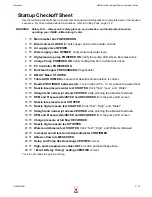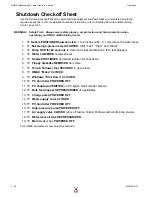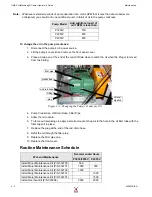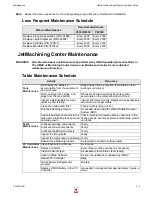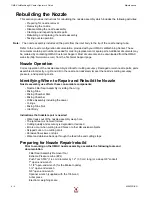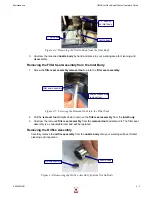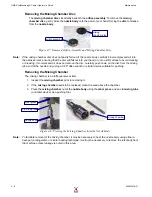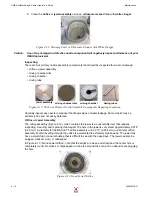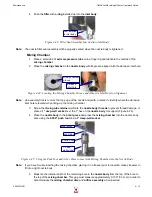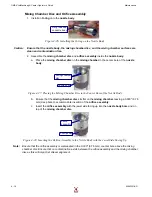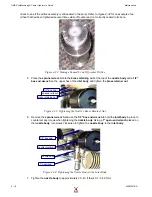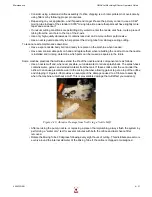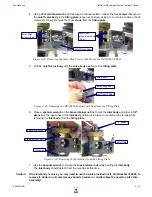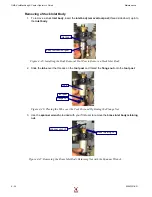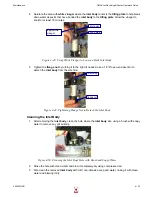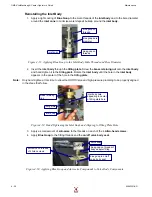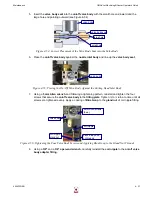
OMAX JetMachining® Center Operator’s Guide
Maintenance
4 - 12
400433D-EN
As the hole in the mixing chamber disc wears, the probability that garnet can travel above the orifice
increases, resulting in a chipped orifice. When a mixing chamber hole is no longer round, it indicates
uneven wear. Figure 4-16 provides examples of worn mixing chamber discs.
Figure 4-16: Worn Mixing Chamber Discs
When the wear pattern is 'star shaped,’ it generally means the orifice or jewel is chipped. This star
pattern develops because the chip is on the edge of the jewel where the jet is formed, resulting in a small
segment of the jet shooting off at a fairly large angle to the opposite side of the jet from where the chip is
located. Multiple chips cause multiple segments of the jet to shoot off to different locations around the
edge of the jewel and erode the star shaped hole.
Erosion or a wear pattern that prevents the mixing chamber disc from seating flat on the mixing chamber
leads to a misaligned jet, causing wear on the mixing tube. Erosion on the bottom surface of the mixing
chamber disc may weaken the disc, leading to eventual cracking.
Mixing Tube
Although the mixing tube (Figure 4-12) is made from an extremely hard material, over time, the flow of
high-pressure water and abrasive will wear away the inside of the mixing tube. This results in a gradual,
irregular widening of the internal diameter of the mixing tube, causing a less accurate stream of abrasive
and water. Figure 4-17 provides some examples of worn mixing tubes. A cross section of these mixing
tubes reveals the irregular wear of their internal diameter.
Figure 4-17: Worn Mixing Tubes
The mixing tube is also very brittle and easily broken if dropped or struck hard. The key to a long mixing
tube life is maintaining a healthy orifice or jewel. Damage to mixing tubes caused by misaligned jets or a
chipped jewel is not apparent when looking through the bore of the mixing tube. The size of the kerf and
cutting performance are the best indicators of mixing tube wear. The kerf is the width of the cut made by
the abrasivejet. It can range from 0.021" (0.53 mm) to 0.060" (1.52 mm), depending on the nozzle, the
thickness of the material being cut, and the amount of wear on the mixing tube.
A clogged mixing tube is most frequently caused by using contaminated abrasive. Because the opening
in the mixing tube is small, 0.030" (0.76 mm) on a MaxJet 5 and 0.021" (0.53 mm) on a MiniJet, even a
small particle of dirt can clog it. Other potential causes of clogging include contaminated or wet abrasive.
Metal chips from other shop operations and paper from the abrasive bag are two common sources of
contamination. Clean the mixing tube and inspect its inlet and outlet ends to see if it needs to be
replaced.
Содержание JetMachining Center 2626
Страница 8: ...OMAX JetMachining Center Operator s Guide viii 400433D EN ...
Страница 12: ...OMAX JetMachining Center Operator s Guide xii 400433D EN ...
Страница 22: ...OMAX JetMachining Center Operator s Guide Safety First 1 10 400433D EN ...
Страница 140: ...OMAX JetMachining Center Operator s Guide OMAX Glossary 6 16 400433D EN ...
Страница 144: ...OMAX JetMachining Center Operator s Guide Index 4 400433D EN ...


